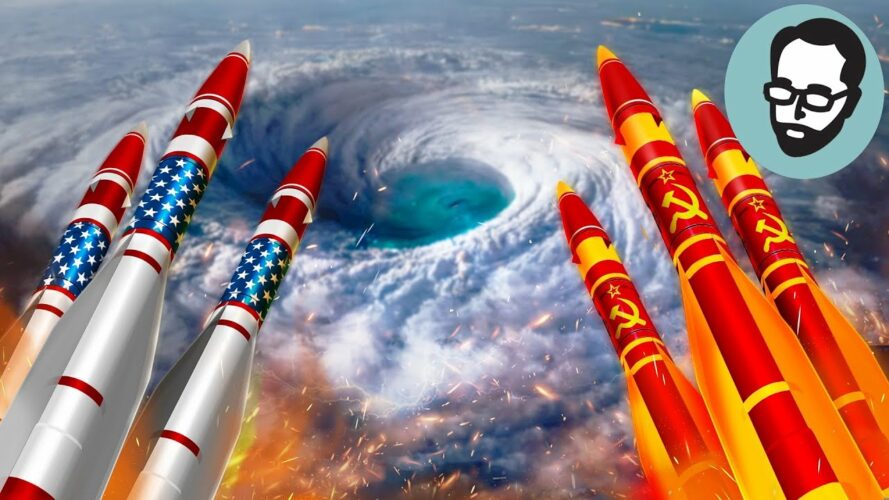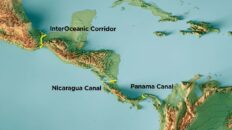On November 12, 1970, a cyclone hit the country of Bangladesh (which was known as East Pakistan at the time) that through a combination of bad timing, location, miscommunication, and political malice became the deadliest storm in human history, killing more than half a million people in one day. It became known as the Bhola Cyclone, and it set in motion a series of events that led to a genocide, a revolution, and brought the world to the brink of nuclear war.
TRANSCRIPT:
Earlier this month, the National Oceanic and Atmospheric Administration released their summary of weather disasters for the United States in 2022.
What they found was that there were 18 weather or climate related events that caused more than a billion dollars in damage, including everything from droughts to floods to wildfires to severe storms, hurricanes, and winter storms. This is more than double the average of 7.9 since 1980, and led to the deaths of 474 people.
Each death is a tragedy, of course. But 474 is practically nothing compared to a cyclone that struck South Asia in 1970.
This one storm killed 600,000 people in one night. Millions more died in the aftermath of the storm, including a famine, a genocide, and a war that believe it or not came thiiiis close to nuclear armageddon.
This was by any conceivable measure, the deadliest storm of all time. A storm that literally almost ended the world. And chances are you’ve never heard about it.
The Deadliest Storm
Okay, yeah, I know everything I just said sounded super hyperbolic and over the top. Well get used to it because everything about this story is crazy over the top.
It also just happens to be true.
It made landfall on November 12th, 1970 in Bangladesh and came to be known as the Bhola Cyclone, named after one of the many islands it pretty much wiped off the face of the Earth.
Why So Deadly?
And the thing is, it wasn’t even that strong of a storm. Don’t get me wrong, it was a bad storm, but it was more just a confluence of unlucky factors that made it so deadly.
A “perfect storm” if you will.
That’s Scott Carney, an anthropologist and author who wrote a book called The Vortex about the Bhola Cyclone. I recently interviewed him for my podcast – Link’s in the description.
But yeah, cyclones — or hurricanes in the U. S. — are categorized on a 5-point scale. The Bhola Cyclone was a Category 4, with sustained winds of up to 185 kilometers per hour.
So we’ve seen stronger storms. But what made the storm so deadly was time and place.
The moon was full on November 12th, and it was high tide when the cyclone struck. Both of which caused a massive storm surge.
In 1970, Bangladesh had a population of 64.2 million people spread across 144,000 square kilometers. That’s about the same size as the state of Iowa, with 2.9 million residents today.
Life on the Delta
Why do so many people live there? For the same reason the ancient Egyptians were able to thrive as an empire. Egypt and Bangladesh are situated on river deltas.
Just as the Nile enriches the soil of Egypt, the Ganges enriches the soil of Bangladesh.
Both rivers drag nutrients from upstream to the ocean. In Bangladesh, the nutrients support bumper crops of rice, tea, and jute, a kind of fiber used to make coffee bags.
When the Bhola Cyclone struck, it depopulated whole islands of the Ganges Delta. Early reports focused on the largest island, Bhola, which is how the cyclone got its name. But there are harrowing stories of survival and loss from all over the area.
Including the Island of Manpura, where as Scott details in the book, there lived a young man named Mohammed Hai.
Mohammad Hai
One was the story of Mohammad Abdul Hai. Hai was only 18 when the Bhola Cyclone made landfall. He was lucky enough to live in a two-story house, which was rare on his native island of Manpura.
Over the years, Hai and his family had weathered countless storms, some very powerful. So on the night of November 12th, they were tucked up in bed when Hai awoke to the sounds of rain on the tin roof and animal noises from outside. He spent an hour trying to get cows in the barn.
By the time he gave up, the rain had become a downpour. With his father away, Hai was in charge. He got his extended family together on the house’s sturdy first floor where they read the Qur’an and listened to palm fronds being stripped from trees by the wind.
Then the flood came. Waves pounded the walls. Water splashed in at the windows.
The family moved upstairs, but the flood kept coming. It mounted the stairs one-by-one, like a monster in a nightmare. When it reached Hai’s feet, he had a idea.
The best chance of survival stood in the yard outside the house. A palm tree there had survived many storms, but to reach the tree, Hai would have to jump. Hai climbed on the roof by an access panel and leapt into the blinding rain.
Success! Hai smacked into the tree and yelled for his family to follow. When nobody answered, he yelled again and again.
For an hour or more, Hai clung to the bark of the tree. All at once, the rain stopped. In just a few seconds, the night turned from chaos to calm.
Hai was in the eye of the storm, not that he knew it. He ran to a neighboring house and told survivors there to climb a tree. His own home was dark and silent, with flood waters near the top of the upstairs room.
When the storm came back, Hai clung to his tree. Hours passed and his arms and legs became gouged by the rough bark. Finally, in early hours of the next morning, the water receded.
Sadly, that was only the beginning of the disaster for Hai. His mother, brother, and most of the rest of his family had drowned. All told, around 40,000 of Manpura’s 50,000 inhabitants were dead.
Hai spent the next week burying corpses in mass graves. He later became an aid worker. And later still, a freedom fighter.
Survivor Tales
There are thousands of similar stories from the cyclone. One grandmother survived because servants tied her to a tree. Then all the servants drowned.
ITOS 1 and Neil Frank
You might wonder why nobody warned the people of Bhola, Manpura, and other islands to evacuate. Well, the irony, if you want to call it that, is that the science of meteorology had recently taken a major step forward.
It was meant to provide infrared and visual photographs for meteorologists to analyze. And it did! The problem was the turnaround time.
Neil Frank, a legendary meterologist who went on to become director of the National Hurricane Center in Florida, was sent a picture of the Bhola Cyclone from shortly before landfall.
He immediately saw the danger and would have sent warnings worldwide. Only, the picture was a week old when it came across his desk.
This wasn’t ITOS 1’s fault. It was working perfectly. It snapped the picture November 12th and transmitted it to NOAA that day.
The problem was there was no real internet back then. That picture couldn’t just be emailed to Neil Frank, they had to put it in an envelope and mail it to him.
It was this disaster, and others like it that led to the building of the infrastructure that made it possible to get that information around the world in a timely manner. Something we take for granted today.
The New Alert
Of course, there were people who knew the storm was coming before it nearly wiped the Ganges Delta islands off the map. Local meteorologists were no strangers to cyclones and they knew what they were looking at.
The problem was, ITOS-1 wasn’t the only new thing in the meteorological world. They had also updated their warning system.
For example, when the local meteorologists saw the storm coming and sent warnings over the radio, they called out “Red 4, Red 4”.
The “red” meaning red alert and the 4 meaning it was a category 4 storm. Specifically a Red 4 meant “Red Alert. Catastrophic destruction imminent. Seek high ground immediately.”
It was actually Neil Frank’s boss at the National Hurricane Center had come up with the wording, that was now being adopted around the world.
But this was new. And had never been used before in Bangladesh, so the people there didn’t really know what the hell “Red 4” even meant.
In fact, they were used to a 1-10 scale. So when they heard “4”, that didn’t sound like a bad storm at all.
So because of this, many who could have evacuated didn’t. And those who could have gone to higher ground stayed put. And as the storm approached, at high tide under a full moon, it happened to turn just the right way to force a giant storm surge up the Ganges Delta.
And a quarter of an area the size of Iowa, with 21 times the population of Iowa, was engulfed by several meters of water. Literally washing half a million people out to sea. All in one night.
The scale of this destruction is something most of us could hardly imagine. But unfortunately, this was just the beginning.
As we’ve seen in many other cases, it wasn’t the disaster itself that caused the most suffering, it was the way people responded to it.
Pakistan’s History
So here’s the deal. Throughout this video I’ve been talking about how this storm hit Bangladesh – technically that’s not true. Because in 1970 Bangladesh didn’t exist.
Back then Bangladesh was a part of Pakistan. Which was waaaay over here. This was West Pakistan. And this was East Pakistan.
Now if you see that map and think that doesn’t make any sense to you, well… You’re not British.
You probably know that the British once controlled India, part of that whole Asian land grab for spices all the European countries were into – remember how everything can be traced back to spice?
Well this was known as the British Raj, and it was made up of land in what is now India, Pakistan, Bangladesh, Myanmar, and Sri Lanka. And in 1947, when the British ended their occupation, they chose to partition this land out along religious lines. Hindu areas became India. Muslim became Pakistan.
If it sounds like I’m oversimplifying this, well, I am. But… So did they.
Because there were two separate groups of Muslims in the British Raj, the Bengalis in the east and the Punjabis in the west. These were entirely separate ethnic groups with different languages and histories and economies and everything.
But the British, in their infinite wisdom decided instead of making them two separate countries, they would just make them one country. Separated.
Like most countries that experience a power vacuum, Pakistan went through decades of wars and coups and power struggles, but by 1970 when the cyclone hit, this was the state of things in Pakistan.
The seat of power was in West Pakistan. East Pakistan was more populous and resource-rich but was divided amongst dozens of political parties so they held less sway and were treated more like a colony of the west than an equal.
At the head of the government in West Pakistan was President Yahya Khan. He was a famed general and war hero from World War 2, and he had big plans for his country.
He had two main goals, one, he wanted to oversee the first free and fair election since Partition. He really saw himself as the George Washington of Pakistan, he wanted to be known as the man who finally brought stability to this country and set it on a course for success.
To that end was his second goal, he wanted to make Pakistan a major player on the world stage. And his plan to do that was to engineer a meeting between the United States and China.
He had a connection with Mao Zedong and he knew that Nixon wanted to open diplomatic relations with China. Of course at the height of the cold war, Nixon couldn’t just openly approach them, so Yahya Khan tried to serve as a back channel between the two.
Nixon and Mao did famously have a summit in 1972, and Yahya Khan played a major part in that. He spent years cultivating a relationship with Nixon and his adviser Henry Kissinger to make it happen.
All of which paints a picture of Yahya Khan as a noble statesman, which he definitely had that side to him. But he also had another side – he was a drunken, genocidal lunatic.
When the Bhola Cyclone made landfall, his all-important election was only 25 days away, less than a month out. One option would have been for him to shower the Bengalis with help to secure their votes. But he did the opposite.
In the spirit of “never let a good disaster go to waste” he withheld aid from East Pakistan. He suppressed news reports and ordered the army to hoard any relief supplies, leading to hangars in airports loaded with food and fuel and clothes while Bengalis starved.
In his mind, Bengalis were less likely to vote for him anyway so why not just let this disaster take out as many of those voters as possible?
In fact, our hurricane specialist Neil Frank visited Pakistan on behalf of the World Bank and had an… interesting exchange with a Punjabi general.
Or, as a general told Neil Frank when he visited Pakistan on a fact-finding mission, “You see, Neil, this cyclone solved about half a million of our problems.”
But this plan backfired when the election came. Because the Bengalis, who normally split among many party lines, unified. They came out in droves and voted for a man named Sheikh Mujibur Rahman, who was the head of a pro-independence party called the Awami League.
Rahman, who went by Mujib to his followers, had spent the last month distributing supplies as far and wide as he could, winning over the hearts and minds of the people. You could say he did it out of kindness or as a campaign tactic, either way, it worked.
So now Yahya Khan, who had made this election his life’s work, not only lost the election, but lost it to a Bengali. A Bengali who wanted independence for East Pakistan.
He now had a choice. He could accept the results of this election that he oversaw, handing over the government to what he considered to be an outsider, watch his country split apart, and lose any chance of making that Nixon-China connection he’d been working on… Or he could do some dictator shit.
He chose to do dictator shit.
He delayed the transfer of power over and over again for months and eventually had Mujib arrested and put in jail. And when the inevitable protests broke out in East Pakistan, he set into action a plan he called Operation Searchlight.
The name “Operation Searchlight” was specifically chosen to be as vague and innocuous sounding as possible. But it was nothing of the sort.
In March 1971, just four months after witnessing the deadliest storm of all time, East Pakistan suffered through one of the worst genocides of the 20th century.
Between March and May, up to 3 million Bengalis were slaughtered by Pakistani forces and millions more fled into neighboring India.
The details of this are horrifying and deserve its own video, which you can find here on Nebula. I’ll warn you though, it’s some pretty stomach churning stuff. Turns out sometimes people really suck.
The details are so horrifying, I couldn’t possibly cover it here. This video’s already flirting with demonetization, so I made a whole separate video on it over on Nebula as part of my Forgotten Atrocities series.
And this definitely fits the description of an atrocity, Yahya Khan’s instructions were basically, “kill 3 million people and the rest will eat out of our hands.” So yeah.
Some of the other topics I’ve covered on that series include the Irish Famine and the Holodomor, which was basically the Ukranian Holocaust.
Both examples of natural disasters made a million times worse by human negligence or outright malice. It’s a bit of a pattern.
By the way, if you haven’t checked out Nebula, it’s the creator-owned streaming service where we are able to post videos and content not because it caters to some algorithm, but because we feel like it matters.
And if the subject of this video is interesting to you, you should check out the Modern Conflicts series from Real Life Lore where he’s covered topics like the Libyan Civil War, the Afghanistan War and the Chinese genocide of the Uygurs.
Turns out there’s a lot of bad stuff going on.
Now, where was I… Oh right, unspeakable human tragedy
So Operation Searchlight led to an all out war as the Bengalis retaliated and fought back. And India, who already had decades of tension with Pakistan, began training and equipping the Bengalis.
This led to a series of skirmishes between India and Pakistan, and this is where things got really messy.
Because India at the time had a cooperative agreement with the Soviet Union. And remember I said a second ago how Yahya Khan had been cultivating a relationship with Nixon? Yeah…
It also turned out the Nixon wasn’t a fan of Mujib and the Awami League because their politics were a little too socialist for his taste.
So now right in the middle of Vietnam, which was basically a proxy war between the US and the Soviet Union… Here comes another one.
But because Vietnam was raging and was so expensive and divisive, Nixon didn’t want to completely get involved in another war, so he attempted a half-measure.
He sent one ship to the Bay of Bengal as a show of force. That ship was the USS Enterprise — the aircraft carrier, not the starship.
Although it did have the power to go where no one had gone before. That place being total nuclear annihilation.
On its own, the Enterprise carried more nuclear firepower than 2000 Hiroshimas. So, that’s one hell of a half-measure.
The Soviets, of course, couldn’t sit idly by and let that happen so they sent a trio of nuclear subs as a countermeasure.
The commander was given a simple order. Don’t let the Americans come in range of targets in India.
And the Americans were given the order to not bow to the Soviet’s show of force because it was worth ending the human race rather than look weak.
So once again, the fate of all of humanity came down to just a few ship captains playing chicken with each other. God, the Cold War was stupid.
The Enterprise inched forward, and the Soviet subs came to the surface. Each communicated to the other that their orders were to set the world on fire if the other didn’t back down.
But luckily for us all, with literal hours before an escalation were to take place, the Bengali (Mutka Bahini) independence forces took the capital of Dhaka, and Pakistan conceded defeat on December 16th, 1971.
Bangladesh was finally a free country. Mujib was released after nearly a year in jail and became the country’s first president and later its first prime minister.
And I would love to say that things were happily ever after from that point, but that’s not the truth.
Truth is, Bangladesh had been completely devastated, first by the worst storm of all time, then by a genocide and civil war that killed up to 3 million people.
Plus, as part of Operation Searchlight, Yahya Khan specifically targeted political figures and the country’s academics and emptied the banks of their reserves with the sole purpose of setting them as far back as possible.
Bangladesh had to rebuild itself from the ground up, which is never easy, and as often happens after revolutions and civil wars, years of struggles by various groups for power led to even more waves of violence.
In fact, Mujib only served as president for 8 months before he was assassinated in 1975.
It really wasn’t until the 90s that Bangladesh was able to find stability and recover from the series of tragedies it had endured.
Since the Bhola Cyclone, our ability to track and predict storms has taken giant leaps, so while we can expect more and bigger storms as our climate changes, hopefully we’ll never have a disaster on this scale again.
By the way, it’s not the last bad storm to hit Bangladesh, in fact, Bangladesh is also – somehow – home to the deadliest tornado in history. It was called the The Daulatpur–Saturia tornado in 1989.
And if you’re wondering, Yahya Khan was ousted as President soon after the war and was put in house arrest for the next 8 years. He died one year after being released and is now remembered as a dark stain on the history of Pakistan.
It’s possible no other country has suffered as much in the last 50 years as Bangladesh. Their story is one of perseverance and grit. And one that we just don’t hear about over here in the US very often. But we should.
Anyway, my interview with Scott Carney is up on the Conversations With Joe Channel, you can find that link down below, go check it out, and you can also find it and the bonus video about Operation Searchlight over on Nebula. Which, I deeply encourage you to do, Operation Searchlight was insane.




Add comment